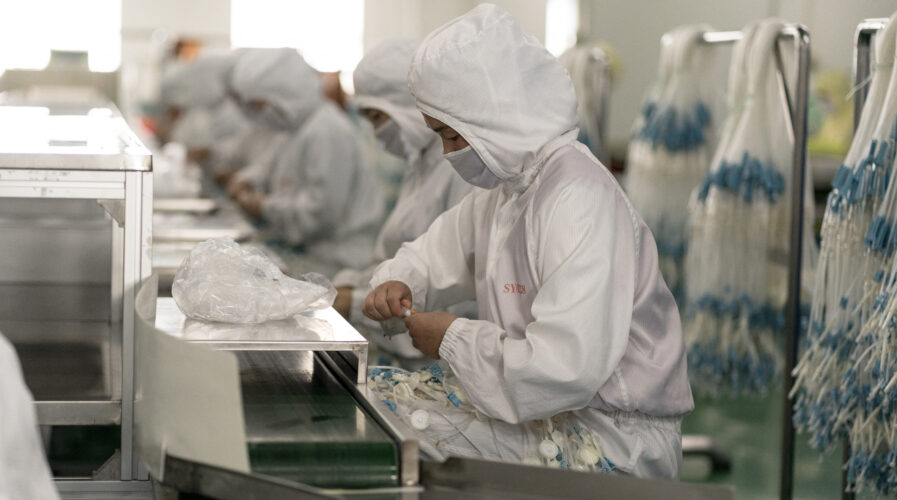
An employee assembles blood-infusion tubes at Jiangsu Suyun Medical Materials factory in Lianyungang, Jiangsu Province, China on September 18, 2021. Jiangsu Suyun Medical Materials is a major medical material supplier that produces blood-infusion sets, tubes, catheter and other medical equipments. (Photo by Raul Ariano / Jiangsu Information Office)
China factory activity slowdown amid Covid outbreaks a growing concern
While the Lunar New Year celebrations have started, COVID-19 is still disrupting factory activity in China. As concerns of supply chain disruption were already expected, the slowdown in output due to the pandemic may only cause more concerns for businesses.
Despite technology enabling most processes to be automated in plants and warehouses, manual labor is still needed for some tasks in these plants. The Chinese city of Xian already had productivity in several manufacturing plants disrupted from COVID-19 after lockdowns were imposed. Several chip companies like Samsung and Micron Technologies reported a half in productivity due to this.
According to a report by AFP, factory activity in China edged down in January, official figures showed, but slightly exceeded expectations as businesses struggled with sporadic disruptions due to coronavirus outbreaks.
The Purchasing Managers’ Index — a key gauge of manufacturing activity — in the world’s second-largest economy inched down to 50.1, just above the 50-point mark separating growth from contraction.
The data from the National Bureau of Statistics (NBS) shows a slight decrease from last month’s reading of 50.3 when activity was buoyed by an easing of commodity prices.
“Faced with a complex and severe economic environment and scattered outbreaks … China’s economy continued to recover and develop, though growth levels somewhat declined,” said NBS statistician Zhao Qinghe.
The NBS reading contrasted with a private survey of smaller manufacturers, which fell by 1.8 points to 49.1.
“The slowdown is particularly severe for the small firms,” said Zhiwei Zhang, chief economist at Pinpoint Asset Management.
The NBS figures have hovered in growth territory since November, following a seven-month downward trend in part due to power shortages and high raw material prices. The reading fell below 50 for two months in September and October as the power crunch hit business operations.
Meanwhile, the non-manufacturing business activity index was 51.1 in January, a contraction of 1.6 points from the previous month.
The decline was due in part to a slowing recovery in the services sector and a seasonal slowdown in construction.
Analysts have warned that domestic coronavirus outbreaks will likely continue to weigh on China’s economy as sporadic outbreaks dent consumer confidence and cause business shutdowns.
Beijing is on high alert for new virus outbreaks as it prepares to host the Winter Olympics in a few weeks.
Authorities locked down an area neighboring Beijing this week following a handful of reported cases, appearing not to publicly announce restrictions that have confined around 1.2 million people in Xiong’an New Area to their homes.
Once again, the effects of the pandemic are continuing to disrupt the global supply chain, especially with factory activity in China being a key component of it. For businesses, technology solutions may ease some processes but at the end of the day, humans are still vulnerable, hence being prepared to deal with any disruption is key.
With additional reporting from © Agence France-Presse
READ MORE
- Ethical AI: The renewed importance of safeguarding data and customer privacy in Generative AI applications
- How Japan balances AI-driven opportunities with cybersecurity needs
- Deploying SASE: Benchmarking your approach
- Insurance everywhere all at once: the digital transformation of the APAC insurance industry
- Google parent Alphabet eyes HubSpot: A potential acquisition shaping the future of CRM


